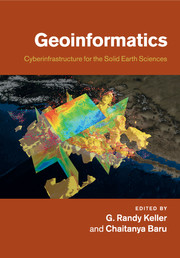Book contents
- Frontmatter
- Contents
- List of contributors
- Preface
- Introduction
- Part I Case studies from other disciplines
- Part II Modeling software and community codes
- Part III Visualization and data representation
- Part IV Knowledge management and data integration
- Part V Web services and scientific workflows
- 12 Service orientation in the design of a community hydrologic information system
- 13 Web services for seismic data archives
- 14 Development of robust data system for gravity and magnetic anomaly data: A case study of a community-based effort for point data
- 15 Scientific workflows for the geosciences: An emerging approach to building integrated data analysis systems
- 16 Online access and processing of LiDAR topography data
- 17 Use of abstraction to support geoscientists' understanding and production of scientific artifacts
- Part VI Emerging international and other efforts
- Index
- Plate section
- References
14 - Development of robust data system for gravity and magnetic anomaly data: A case study of a community-based effort for point data
from Part V - Web services and scientific workflows
Published online by Cambridge University Press: 25 October 2011
- Frontmatter
- Contents
- List of contributors
- Preface
- Introduction
- Part I Case studies from other disciplines
- Part II Modeling software and community codes
- Part III Visualization and data representation
- Part IV Knowledge management and data integration
- Part V Web services and scientific workflows
- 12 Service orientation in the design of a community hydrologic information system
- 13 Web services for seismic data archives
- 14 Development of robust data system for gravity and magnetic anomaly data: A case study of a community-based effort for point data
- 15 Scientific workflows for the geosciences: An emerging approach to building integrated data analysis systems
- 16 Online access and processing of LiDAR topography data
- 17 Use of abstraction to support geoscientists' understanding and production of scientific artifacts
- Part VI Emerging international and other efforts
- Index
- Plate section
- References
Summary
Introduction
Key elements in various descriptions of geoinformatics as a field of research development (e.g., Sinha, 2006; www.geoinformatics.info/; Keller, this volume) include open access to data as well as a software toolbox for processing and analyzing the data. However, if a particular type of data is to be useful to a broader community for integrated analysis, raw data must be organized, edited, and formatted into a database that meets a minimal set of community standards for content, processing, and metadata (e.g., FGDC, 1998). In order to make the database useful to non-experts, it should be the foundation of a data system that includes features such as tutorials on how to use the data and software tools for data processing, analysis, and mapping.
Measurements of Earth's gravity and magnetic fields are examples of point measurements that are relatively straightforward to make and qualitatively and quantitatively interpret, and considerable amounts of these data reside in the public domain. These data are useful in a wide variety of applications ranging from groundwater, environmental and natural hazard investigations, to exploration for natural resources, and to studies of deep earth structure. Thus, they are of broad utility to the geoscience community. This chapter presents a case study of the development of a data system that is based on new databases for both gravity and magnetic field point measurements that are downloadable, and contains tutorials and related software tools that have been developed to support data analysis and integrated geologic/geophysical investigations.
- Type
- Chapter
- Information
- GeoinformaticsCyberinfrastructure for the Solid Earth Sciences, pp. 224 - 236Publisher: Cambridge University PressPrint publication year: 2011
References
- 1
- Cited by



